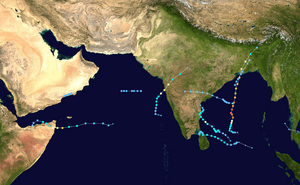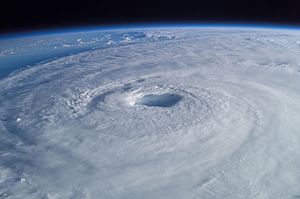2020 North Indian Ocean cyclone season facts for kids
 |
|
| Season summary map | |
| First storm formed | May 16, 2020 |
|---|---|
| Last storm dissipated | Season ongoing |
| Strongest storm | Amphan – 925 hPa (mbar), 240 km/h (150 mph) (3-minute sustained) |
| Depressions | 1 |
| Deep depressions | 1 |
| Cyclonic storms | 1 |
| Severe cyclonic storms | 1 |
| Very severe cyclonic storms | 1 |
| Super cyclonic storms | 1 (record high, tied with 1977, 1989, 1990, 1991, 1999, 2007 and 2019) |
| Total fatalities | 118 total |
| Total damage | > $13.35 billion (2020 USD) |
| North Indian Ocean cyclone seasons 2018, 2019, 2020, 2021, 2022 |
|
The 2020 North Indian Ocean cyclone season is a period when tropical cyclones form in the North Indian Ocean. These powerful storms are also known as hurricanes or typhoons in other parts of the world. The North Indian Ocean has two main seasons for cyclones: one from April to June and another from September to December. Most storms happen in May and October.
A tropical cyclone is a fast-spinning storm system. It has a low-pressure center, strong winds, and thunderstorms. These storms get their energy from warm ocean waters. They can bring heavy rain, strong winds, and big waves to coastal areas.
So far, the 2020 season has seen one major tropical cyclone. This storm was named Cyclone Amphan.
Cyclone Amphan
Cyclone Amphan was the strongest storm of the 2020 season. It was also the most powerful cyclone in the North Indian Ocean since 2007. Amphan caused a lot of damage and affected many people.
The storm formed in the Bay of Bengal. It quickly grew stronger over the warm ocean waters. Amphan became a very severe cyclonic storm. It brought very strong winds and heavy rainfall.
Amphan made landfall in May 2020. It hit parts of India and Bangladesh. The storm caused widespread destruction. Many homes and buildings were damaged. Trees were knocked down, and power lines were broken.
Sadly, Cyclone Amphan led to the loss of lives. It also caused a lot of economic damage. People worked hard to help those affected by the storm. Relief efforts provided food, water, and shelter.
What is a Tropical Cyclone?
A tropical cyclone is a type of storm. It forms over warm ocean waters. These storms have a central "eye" where the weather is calm. Around the eye, there is a wall of very strong winds and heavy rain.
Tropical cyclones are known by different names. In the Atlantic Ocean, they are called hurricanes. In the Pacific Ocean, they are often called typhoons. In the North Indian Ocean, they are called cyclones.
These storms can be very dangerous. They can cause storm surges. A storm surge is a rise in sea level. It happens when the strong winds push water towards the coast. This can cause severe flooding in low-lying areas.
Scientists track tropical cyclones. They use satellites and special planes. This helps them predict where the storms will go. Warnings are then issued to people in the path of the storm. This gives people time to prepare and stay safe.
See also
 In Spanish: Temporada de ciclones del Índico Norte de 2020 para niños
In Spanish: Temporada de ciclones del Índico Norte de 2020 para niños 


